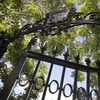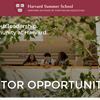Murray has echoed the importance of integration between engineering and the liberal arts and has repeatedly stated her objective that “all graduates, whatever their field, leave [Harvard] with a well-developed literacy in technology.”
Morrisett, who teaches Computer Science 51: “Introduction to Computer Science II,” said that the broad appeal of these courses attracts a community of students who might not intuitively consider themselves engineers.
“In CS50 and CS51, we try to draw on domains that aren’t just for nerds; 51 has problem sets that deal with music or 50 has problem sets that deal with photography and imagery,” Morrisett said. “Once you have a good cohort of students that aren’t just engineers, it becomes a lot easier for students to team up and take those kinds of classes together.”
Thanks to its rapid growth and industrial connections, SEAS has continued to receive generous funding despite the economic decline and funding cuts to research across the nation.
“There’s a big pool of money that’s partly driving the expansion of the faculty,” said David D. Cox ’00, an associate professor in molecular and cellular biology and computer science, explaining that this support is not as reliable in other parts of the University.
In addition to planning new facilities in Allston, Loncar said the University has accommodated alternative formats of learning and teaching through expanded budgets for classroom ventures. In Loncar’s class ES50, for example, each student group received around $100 to build a final project.
“When we actually introduced the final project component where students build hardware and design cool stuff instead of the final exam, enrollment skyrocketed,” Loncar said.
BUILDING BRIDGES
When archaeologists embarked on a mission to save the Dead Sea Scrolls—a collection of 2,000-year-old documents that contain the earliest known copies of the Hebrew Bible—they enlisted SEAS’ help. A room full of computer scientists and engineers discussed ways to determine rates of decay while historians worried whether the documents could survive another two millennia of natural decline.
This interdisciplinary partnership, orchestrated by the Harvard Initiative for the Science of the Human Past, is part of the newly emerging field of digital humanities.
“[The project] just evinces this sort of breadth of reach of engineering and computer science into just about everything,” said Cox, who was among the SEAS faculty consulted for the initiative.
Engineering tools can shape the way humanities are studied, but the study of engineering itself also overlaps substantively with a wide range of fields. Administrators said that SEAS especially hopes to capitalize on these connections by integrating an engineering mindset into other divisions on campus.
“Atmospheric research will continue to intersect with earth science; bioengineering will always learn from OEB and genetics; data privacy crosses over with the social sciences and law; and applied mathematics frequently lends insights to economics,” wrote Murray. “The reality is that across Harvard, we all benefit from our strengths in diverse fields.”
Executive Dean for Education and Research Fawwaz Habbal confirmed that the SEAS mission is inextricable from Harvard’s broader commitment to providing students with a strong liberal arts foundation.
“We don’t feel that our mission will be fulfilled without liberal arts. We have no intention to become a mini-MIT, a mini-Georgia Tech,” he said. “We are inside Harvard for a function.”
Read more in Faculty News
The Rise of Student Research












